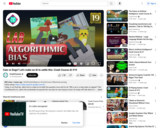
CashOnHand - Glossary - Billy - Spanish
- Subject:
- Business and Communication
- Education
- English Language Arts
- Finance
- Speaking and Listening
- Material Type:
- Lesson
- Date Added:
- 07/19/2021


CashOnHand - Glossary - Billy - Spanish

CashOnHand - Housing - Shawn - English

CashOnHand - Housing - Shawn - Spanish

Financial literacy - CashOnHand - Income - Alina - ASL/English

Financial literacy - CashOnHand - Income - Alina - ASL/Spanish

CashOnHand - Independent Living Skills - Leilani - English

CashOnHand - Independent Living Skills - Leilani - Spanish

Financial literacy - CashOnHand - Needs vs Wants - Don - ASL/English

Financial literacy - CashOnHand - Needs vs Wants - Don - ASL/Spanish

Financial literacy - CashOnHand - Ready to Work - Toni - ASL/English

Financial literacy - CashOnHand - Ready to Work - Toni - ASL/Spanish

CashOnHand - Summary - Seth - English

CashOnHand - Summary - Seth - Spanish

Today, we’re moving on from game consoles to talk about a bigger shift that was happening in the gaming industry. In the mid 2000s, we saw a proliferation of Internet accessible devices and with them gaming would expand to a new audience. We’re going to talk about two types of games that are found on these devices, social and mobile games, which together we’ll call casual games. Now, the definitions of these terms can get a little muddy, as they’re continuously evolving, but largely what was seen in the industry was a widespread adoption of asynchronous, socially driven gameplay. These changes spurred the industry to change its profit model, and by 2015, these casual games now make up nearly half of all video game industry revenue. And with their easier mechanics, lower price point, and social component these casual games helped integrate gaming into our daily lives like never before.

Today, in our final lab, Jabril tries to make an AI settle the question once and for all, "Will a cat or a dog make us happier?" But in building this AI, Jabril will accidentally incorporate the very bias he was trying to avoid. So today we'll talk about how bias creeps into our algorithms and what we can do to try to account for these problems.

Este sitio web es de Leonardo Moya

This lesson has students use the coding program scratch to create a project for plant and animal cell organelles.

Today we’re going to build the ticking heart of every computer - the Central Processing Unit or CPU. The CPU’s job is to execute the programs we know and love - you know like GTA V, Slack... and Power Point. To make our CPU we’ll bring in our ALU and RAM we made in the previous two episodes and then with the help of Carrie Anne’s wonderful dictation (slowly) step through some clock cycles. WARNING: this is probably the most complicated episode in this series, we watched this a few times over ourselves, but don't worry at about .03Hz we think you can keep up.

Learn how to use 'chaining', a common technique in jQuery for chaining a sequence of method calls together.

How would you like to travel to new places while collaborating on a geospatial data challenge with students from around the world? In this class, students collaborate on a global-scale geospatial analysis problem with a focus on data analytics and professional practice in Geographic Information Systems. Penn State MGIS students collaborate with graduate students from ITC - University of Twente in Enschede, Netherlands to develop solutions to analyze spatio-temporal patterns in refugee migration data. Students have the opportunity to present their work and develop new connections with EU geospatial professionals via site visits to European national mapping agencies. Students work in teams to use geospatial analytics to arrive at a solution to visualize patterns over space and time.